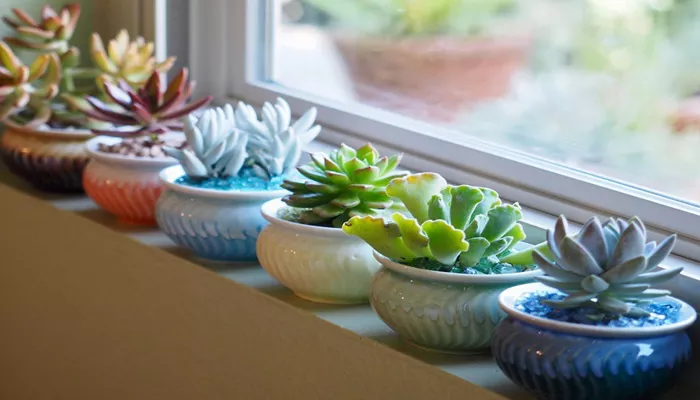Succulents, with their plump leaves and vibrant colors, have captivated the hearts of many plant enthusiasts. One of the most rewarding aspects of caring for succulents is propagating them from leaves. This process not only expands your collection but also provides an opportunity to explore the fascinating world of plant growth. In this article, we’ll delve into the step-by-step process of rooting succulent leaves, explore some novel techniques, and offer tips to ensure successful propagation.
Understanding Succulent Propagation
Propagation is the process of creating new plants from existing ones. For succulents, this can be achieved through several methods, including leaf cuttings, offsets, and seeds. Rooting succulent leaves is one of the most straightforward and gratifying methods. By following the right techniques, you can turn a single leaf into a thriving new plant.
Why Choose Leaf Propagation?
Leaf propagation is popular for several reasons:
Simplicity: It requires minimal materials and can be done at home.
Cost-effective: It’s a low-cost way to expand your plant collection.
Educational: It provides a hands-on learning experience about plant growth and care.
The Basics of Rooting Succulent Leaves
Selecting the Right Succulent
Not all succulents are equally suited for leaf propagation. Some of the best candidates include:
Echeveria: Known for its rosette shape and variety of colors.
Jade Plant (Crassula ovata): A popular choice due to its thick, fleshy leaves.
Sedum: Varieties like Sedum morganianum, or “burro’s tail,” are excellent for propagation.
When choosing a succulent for propagation, ensure it is healthy and free from pests or diseases. A strong, vibrant plant will produce better results.
Preparing the Leaf
Choose a Healthy Leaf: Look for leaves that are plump and firm. Avoid those that are damaged or shriveled.
Gently Twist the Leaf: Using your fingers, twist the leaf off the stem. Ensure that you remove it cleanly, leaving no part of the leaf attached to the stem. A clean removal is crucial as it helps prevent rot.
Letting the Leaf Callous
After removing the leaf, let it dry out and callous over for 3-5 days. Place the leaf in a dry, shaded area to prevent any moisture from causing rot. The callous helps protect the leaf and prevent disease.
Rooting Techniques for Succulent Leaves
Method 1: Soil Propagation
Choose the Right Soil: Use a well-draining succulent or cactus soil mix. You can also make your own mix by combining regular potting soil with perlite or sand.
Place the Leaf on Soil: Lay the calloused leaf on the surface of the soil, ensuring it is in contact with the soil but not buried.
Water Sparingly: Lightly mist the soil every few days to keep it slightly moist. Overwatering can lead to rot.
Provide Indirect Light: Place the pot in a bright, indirect light area. Avoid direct sunlight, as it can dry out the leaf too quickly.
Method 2: Water Propagation
Prepare a Container: Use a shallow dish or container with no drainage holes.
Add Water: Fill the container with a small amount of water, enough to submerge the base of the leaf but not the entire leaf.
Position the Leaf: Place the leaf in the water, ensuring it’s supported and not submerged.
Change Water Regularly: Replace the water every few days to prevent stagnation.
Wait for Roots: Once roots form (typically within 2-4 weeks), transfer the leaf to soil.
Method 3: Hybrid Approach
Combine both soil and water propagation methods by first allowing the leaf to develop a callous and then placing it in a shallow container with a small amount of water until roots start to emerge. After rooting, move the leaf to soil.
Care and Maintenance
Monitor Growth
Once roots begin to form, the leaf will start producing tiny offsets or “pups” at the base. These small plantlets are the beginnings of a new succulent. Continue to provide care by:
Avoiding Overwatering: Water only when the soil is completely dry. Overwatering can lead to root rot.
Providing Adequate Light: Ensure the plant receives sufficient light to encourage healthy growth.
Fertilizing Occasionally: Use a diluted, balanced fertilizer to provide essential nutrients.
Transplanting
When the new plantlet has developed a sufficient root system and is growing well, it’s time to transplant it into a larger pot. Gently remove it from the soil or water and place it in a new pot with fresh succulent soil.
see also: How to Plant Succulents in Rocks?
Troubleshooting Common Issues
Rotting Leaves
If the leaves are turning mushy or discolored, it may be due to excess moisture. Reduce watering and ensure proper air circulation.
Pest Infestation
Watch for signs of pests like mealybugs or aphids. Treat infestations promptly with appropriate methods, such as insecticidal soap or neem oil.
Lack of Root Development
If roots are slow to develop, it may be due to inadequate light or moisture. Ensure the leaf is in a suitable environment and adjust care as needed.
Conclusion
Rooting succulent leaves is a rewarding and relatively simple process that can enhance your plant collection and deepen your understanding of plant care. By selecting healthy leaves, using the right propagation techniques, and providing appropriate care, you can successfully grow new succulents from leaves. Whether you choose soil propagation, water propagation, or a hybrid approach, patience and attention to detail are key.
Experiment with different methods, and don’t be afraid to try propagating various types of succulents. With practice, you’ll become more adept at nurturing these fascinating plants and enjoy the beauty of a flourishing succulent garden.
Related topics:
- How Much Water Is Used for a Succulent Terrarium?
- How to Plant Succulents in a Tree Stump?
- How to Make Succulent Cuttings?


